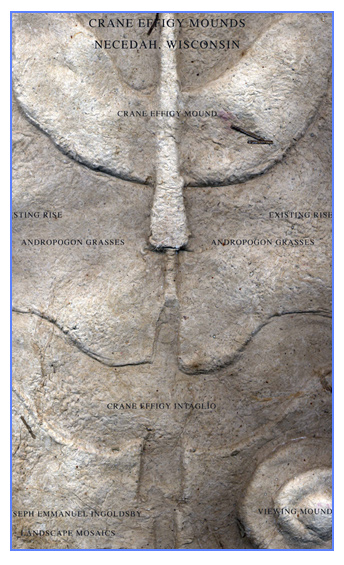The whooping crane is an ancient class
of birds, which soared across the heartland of America, since time
immemorial,
in migration flight
to the Gulf coast. Their migration pattern echoes the migration
of the native Woodland people from the Mississippi River to
the Gulf coast.
These magnificent birds’ size, color and vocalization must have
made quite an impression on the indigenous people of America. The
whooping crane is a bird of the water, earth and sky. The whooping crane
stands
five feet tall with a seven-foot wingspan, which in soaring flight
appears white against the sky. In tribute to the natural and cultural
history
of Wisconsin, the Crane Effigy Mounds earthwork represents the
whooping crane’s habitat of water- intaglio, earth- prairie grass
mounds and sky- animated flight pattern. The mound forms reference and
pay respect
to the early effigy mounds built between A.D. 700 and 1200 by the
Woodland native culture. The mounds are constructed of tamped native
soil over
a colored mineral earth marking. The soils are stabilized with
native andropogon- little blue stem prairie grasses. A coiled ramp observation
mound at an existing hill allows visitors visual access to the
earthwork
from Birch Street in Necedah Village. The Crane Effigy Mounds will
also be visible from the air and create a threshold and landmark to the
Necedah
National Wildlife Refuge of wetlands and woodlands, where whooping
cranes and other wildlife breed within the “land of yellow waters”.
|





